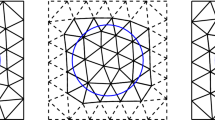Summary
This paper considers the finite element approximation of the semi-definite Neumann problem: −∇·(σ∇u)=f in a curved domain Ω⊂ℝn (n=2 or 3),\(\sigma \frac{{\partial u}}{{\partial v}} = g\) on πΩ and\(\int\limits_\Omega {u dx} = q\), a given constant, for dataf andg satisfying the compatibility condition\(\int\limits_\Omega {f dx} + \int\limits_{\partial \Omega } {g ds} = 0\). Due to perturbation of domain errors (Ω→Ωh) the standard Galerkin approximation to the above problem may not have a solution. A remedy is to perturb the right hand side so that a discrete form of the compatibility condition holds. Using this approach we show that for a finite element space defined overD h, a union of elements, with approximation powerh k in theL 2 norm and with dist (Ω, Ωh)≦Ch k, one obtains optimal rates of convergence in theH 1 andL 2 norms whether Ωh is fitted (Ωh≡D h) or unfitted (Ωh⊂D h) provided the numerical integration scheme has sufficient accuracy.
Similar content being viewed by others
References
Babuška, I., Aziz, A.K.: Survey lectures on the mathematical foundations of the finite element method. In: Aziz, A.K. (ed.), The Mathematical Foundations of the Finite Element Method with Applications to Partial Differential Equations, pp. 3–363. New York: Academic Press 1972
Barrett, J.W., Elliott, C.M.: A finite element method for solving elliptic equations with Neumann data on a curved boundary using unfitted meshes. IMAJ Numer. Anal.4, 309–325 (1984a)
Barrett, J.W., Elliott, C.M.: Total flux estimates for a finite element approximation of elliptic equations. IMAJ Numer. Anal. (to appear)
Barrett, J.W., Elliott, C.M.: Finite element approximation of elliptic equations with a Neumann or Robin condition on a curved boundary. IMAJ Numer. Anal. (submitted)
Ciarlet, P.G., Raviart, P.A.: The combined effect of curved boundaries and numerical integration in isoparametric finite element methods. In: Aziz, A.K. (ed.), The Mathematical Foundations of the Finite Element Method with Applications to Partial Differential Equations, pp. 409–474. New York: Academic Press 1972
Ferris, D.H., Martin, D.W.: Numerical solution of discrete Poisson-Neumann problems with compatible or incompatible data, with reference to flow in a circular cavity. IMAJ Numer. Anal.5, 79–100 (1985)
Forsythe, G.E., Wasow, W.R.: Finite Difference Methods for Partial Differential Equations. New York: Wiley 1960
Kufner, A., John, O., Fucik, S.: Function Spaces. Leyden: Nordhoff 1977
Molchanov, I.N., Galba, E.F.: On finite element methods for the Neumann problem. Numer. Math.46, 587–598 (1985)
Nečas, J.: Les Měthodes Directes en Thěorie des Equations Elliptiques. Paris: Masson 1967
Nedoma, J.: The finite element solution of elliptic and parabolic equations using simplicial isoparametric elements. RAIRO Anal. Numer.13, 257–289 (1979)
Author information
Authors and Affiliations
Additional information
Partially supported by the National Science Foundation, Grant #DMS-8501397, the Air Force Office of Scientific Research and the Office of Naval Research
Rights and permissions
About this article
Cite this article
Barrett, J.W., Elliott, C.M. A practical finite element approximation of a semi-definite Neumann problem on a curved domain. Numer. Math. 51, 23–36 (1987). https://doi.org/10.1007/BF01399693
Received:
Issue Date:
DOI: https://doi.org/10.1007/BF01399693




